When you first started smoking, you probably had a moment when you smoked so much that you started to feel uncomfortable and too high. It’s unlikely that the high was any good after that. You, my friend, dealt with a classic case of greening out. But don’t worry; we’ve all been there.
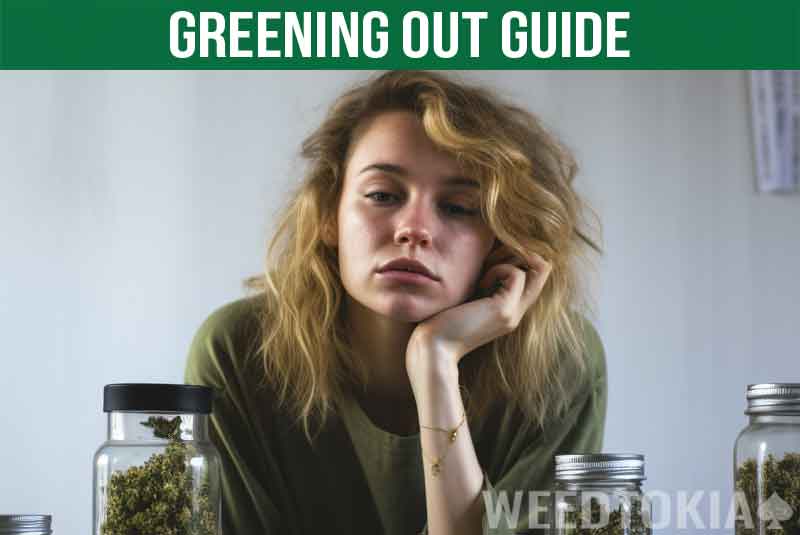
Greening out means you consumed too much marijuana, causing uncomfortable, disorienting symptoms that may take you a while to recover from.
This guide will let you in on the crucial details of mild to severe cannabis overdoses and what you can do to avoid them.
Table of Contents
How To Know If You’re Greening Out: Symptoms
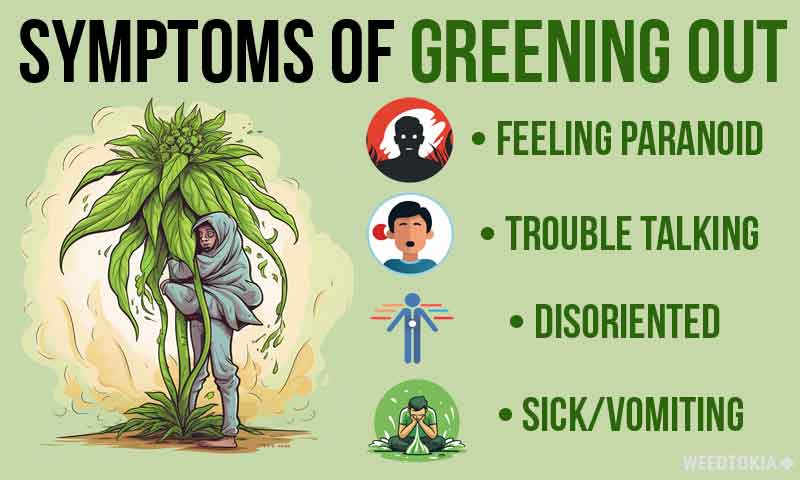
Greening out can be scary, especially if you’re unaware of what’s happening in your body. Arming yourself with knowledge can take the edge off and even prevent the issue entirely.
The main symptoms of greening out are:
- Paranoia
- Feeling disoriented
- Slurring words/difficulty talking
- Feeling sick and nauseous
- Loss of coordination
- Heart racing
- Feeling lightheaded
To prevent “greening out” or “cannabis overdose,” you need to know your individual tolerance, along with some general rules of thumb, mainly general guidelines for what constitutes an “excessive” cannabis dose.
Often, cannabis users end up greening out because they didn’t wait long enough to start feeling the herb’s effects. Just know that inhaled doses ranging from 2-3 mg of THC and ingested doses between 5-20mg of THC are enough to impair you. So, it’s likely that these doses are enough to get you high.
Still, even if you’re prepared, there’s always a chance you’ll slip up and smoke or eat too much weed. In this case, the key symptoms that’ll confirm you’ve indeed exceeded your tolerance, in addition to those listed above, include difficulty holding a conversation, panic attacks, loss of coordination and motor control, paranoia, vomiting, and hallucinations.
Some of these symptoms may seem a bit scary but don’t worry. Despite the deadly connotation of the word “overdose,” too much cannabis doesn’t always throw you into a panic.
You might also experience what some experts have called “milder overdoses.” These are marked by nausea, loss of energy, paranoia, and anxiety.
In any case, the most severe symptoms you’ll want to watch out for include cannabinoid hyperemesis syndrome (CHS) and marijuana-induced psychosis (MIP).
What To Do If You’re Greening Out (Tips to Relax)
Greening out can be scary. Believe me, I know. I’ve seen many people freak out while they were greening out. It can even happen to experienced cannabis consumers. There’s always that one strain that’s just a little too much for you.
In other cases, cannabis may not have been a problem at all. You might have accidentally taken a hit that was way too big or misread the label on an edible and eaten too much.
Regardless of how you ended up greening out, remind yourself that it’s temporary. You may be caught off-guard now, but after this experience, you know yourself and the herb much better, and you’ll be able to avoid such mistakes in the future.
Here Are Some Things To Do If You’re Greening Out:
- Try to relax; remember it’s just weed, and you’ll feel better with time. Here is a good video to watch if you’re feeling too high.
- Eat some food or drink a sugary drink. This can help you feel a little less high.
- Stay distracted to keep your mind off how you’re body is feeling. Sometimes thinking about how you’re feeling just makes it worse.
- Watch a movie you’ve seen before. Don’t watch something that might surprise you or scare you.
- Talk to friends.
- Take a shower. Taking a shower can make you feel less high.
- Go for a short walk in an area you know is safe.
- Make fresh lemonade. Lemonade is known to be a good drink to help you sober up and calm down if you’re too high.
- Put yourself in a good mindset. Realize that panicking isn’t going to do you any good.
- Stay hydrated.
How To Avoid Greening Out
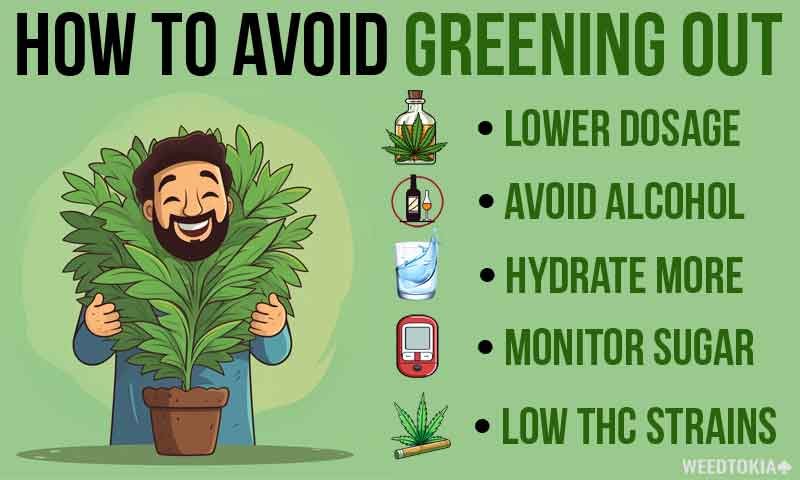
Needless to say, greening out is not fun. Although it can make a funny story in hindsight, your health isn’t worth the risks associated with overdosing.
So, how do you avoid it?
Once you get to know the risks of a cannabis overdose and determine your general tolerance threshold, it’ll be easy to avoid a green-out. That’s more easily said than done, so check out these tips to ensure you have an enjoyable, stress-free high.
Start With A Low Dose
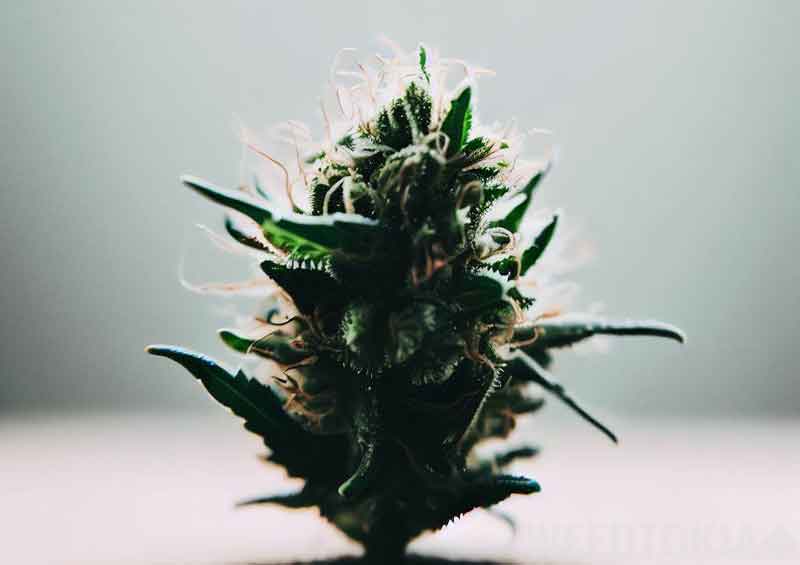
Experienced cannabis users may be better prepared to consume high-percentage botanical products or concentrates than beginners or infrequent users. They’ve developed a higher tolerance to the herb’s effects, making them far less susceptible to greening out.
With that said, it’s best for beginners to start with low doses. It’s easy to go overboard if you don’t know how your body or mind will react.
It’s often suggested to start with doses of less than 10 mg. Anything more than that will be too strong.
Once you’ve smoked or snacked on an edible, wait for about 30 minutes to two hours. At that point, you should start feeling the effects.
Don’t Drink Alcohol
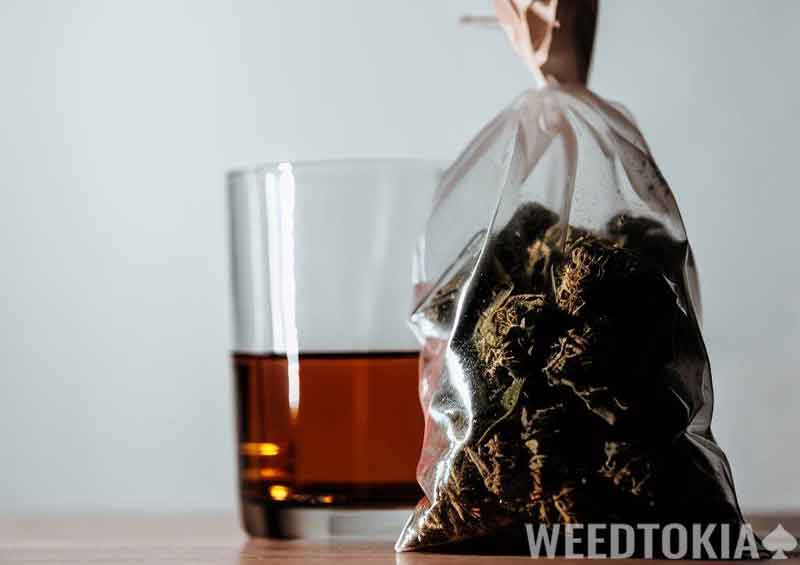
As mentioned earlier, drinking alcohol while consuming cannabis is a bad idea. A high-enough BAC can exacerbate cannabis’s effects, increasing the likelihood that you’ll get sick from enhanced THC effects.
Concerning prescription medications, some drugs are more likely to interact with cannabis than others.
For instance, researchers state that the drugs most inclined to produce additive effects when taken alongside marijuana are sympathomimetics, central nervous system depressants, and anticholinergics.
Sympathomimetics are medications that mimic responses to sympathetic nerves, part of the sympathetic nervous system (SNS). The SNS is a subdivision of the autonomous nervous system (ANS) and helps regulate subconscious functions.
On the other hand, central nervous system depressants are drugs that slow your brain down, making them helpful for calming anxiety and sleep disorders.
Lastly, anticholinergics are designed to interfere with acetylcholine, a chemical messenger, and help manage certain bodily functions. For example, they can help manage urinary incontinence.
Read about your medications and the potential side effects before taking your prescription and cannabis at the same time or within a short period of each other.
Stay Hydrated
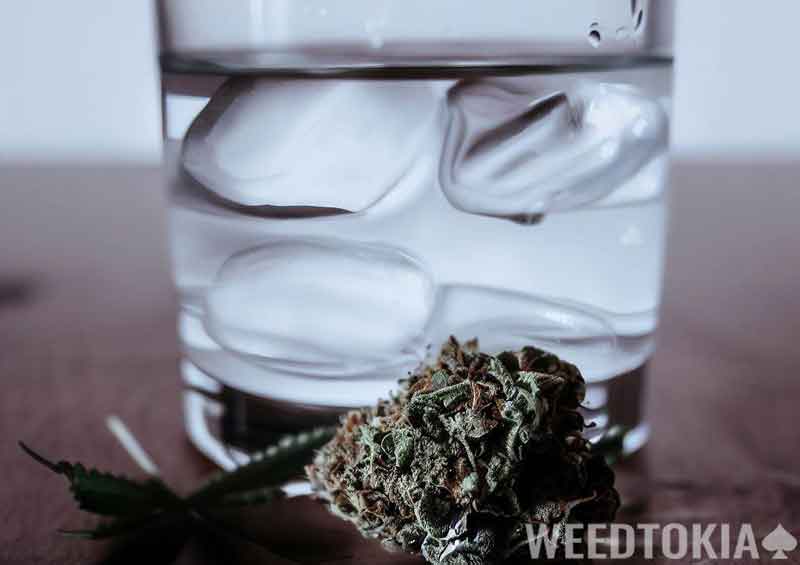
Keep hydrated by drinking lots of fluids while you enjoy your cannabis products. Also, make sure to keep food in your stomach.
(In my experience, too much THC has significantly worse effects if I’m smoking on an empty stomach.)
Advanced Holistic Public Health Nurse, Courtney Allen-Gentry, suggests that you mix lemon juice in your water. The citrus will help neutralize the terpenes’ effects, while the water prevents dehydration from THC consumption.
You can also chomp on some peppercorns in the meantime, as this will help shift the discomfort away from the terpenes’ influence on your body.
Still not feeling well? Try taking some CBD oil. Studies show that CBD can counteract the adverse effects of THC, so you may be able to curb the weed overdose by adding a few drops to your water, or taking a sublingual CBD product for faster relief.
Try Low THC Products
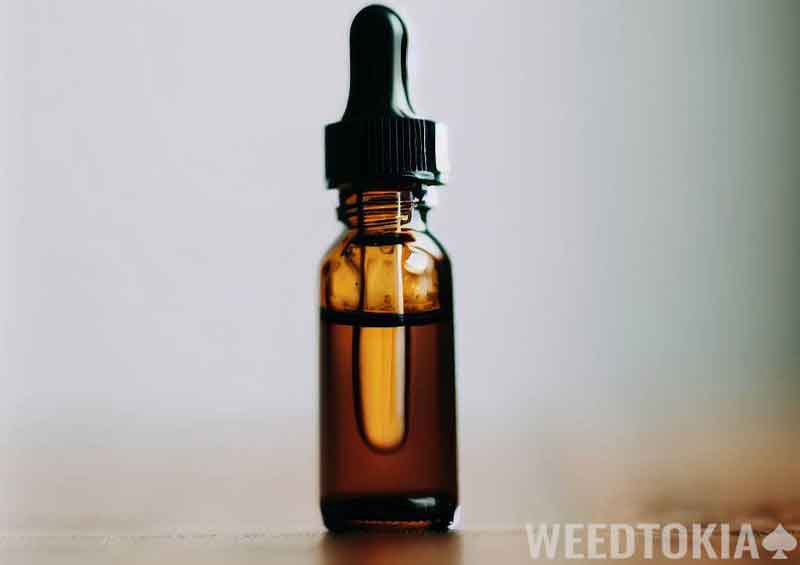
You’re more likely to experience greening out if you’ve consumed far too much THC than your body can handle. When people say they only want one or two hits instead of smoking a whole bowl, it’s not just an arbitrary limit. They know their body, and they’re consciously avoiding an unpleasant high by smoking too much.
Unfortunately, many of the cannabis products on the market nowadays have sky-high THC levels. I’ve seen some reach up to 29%! This is pretty crazy, considering that marijuana typically only had about 2% THC during the 60s and 90s.
Now, newbies have slim pickin’s when it comes to low-THC cannabis products. Of course, you can always opt for CBD, but that’s no fun. If you’re smoking recreationally but don’t know how much THC you can handle, start with a product that’s 10% or less.
Take two or three hits (pipe or bong, not a joint, as it’s much easier to smoke too much with these). See how you feel after 30 minutes, and take another hit if you need it. Smoking flower works much more quickly than ingestible cannabis, so this timeframe should be enough to make it clear whether it’s working for you or not.
Smoke With Buddies

I can’t stress this enough: If you’ve never smoked before, do not smoke alone. It’s unlikely you’ll have a good time since you won’t know when to stop. Again, it is really easy to smoke too much.
The first time I smoked, I didn’t like it much. I was frightened and complained to a friend that I and the world were “moving too slowly.”
(My perception of time was dramatically warped, so it felt like everything was in slow motion. Plus, I was dizzy, so that didn’t help.)
Enjoying a “quiet high” on your lonesome can be peaceful. Eventually, you might prefer it over smoking with other people. However, when you’re just starting out, don’t get too cocky. You’ll likely need some moral support, especially if you don’t know what to expect.
Being around other people will help take your mind off the adverse symptoms if they do arise. Plus, you’ll have loved ones near to talk you through it. Heck, they’ve probably greened out once or twice, anyhow!
Watch Out For Edibles

Always check the label before consuming any cannabis edible. Most of these will contain 100-150 mg of THC, depending on the product type.
They’re available in numerous forms; some of which come in prepared doses, such as a chocolate bar with 10 mg squares, or in servings you’ll need to measure for yourself. Again, remember not to exceed 10 mg your first time.
One of the biggest, most common mistakes is for people to underestimate just how potent their cannabis edible is. You’ll be fooled by the sweetness of the chocolate or fruitiness of the gummy and forget that you’re munching through a bag of medicated treats!
Measure out your cannabis snacks ahead of time. Don’t leave the decision up to your cravings and taste buds. And don’t underestimate those pot brownies!
Marijuana-Induced Psychosis

This is one of the most widely cited risks of consuming too much marijuana. That’s understandable, as psychological effects are central to cannabis’s appeal for medical, social, and adult-use consumers.
Yet, it’s crucial to understand the authentic psychological risks associated with cannabis use, as these effects don’t always manifest to the same extent between individuals.
Some cases are mild; others are more severe. Furthermore, some cannabis-induced psychotic episodes only last a few minutes, while others can influence an individual’s cognitive functioning for years.
Cannabis-induced psychosis symptoms are split into two main groups: positive and negative.
Positive effects include delusions, hallucinations, and a lack of organization in thinking patterns, speech, and behavior. The affected individual will also display abnormal movements.
On the other hand, negative symptoms are less noticeable to others and much more subjective. The individual might have weaker emotional expression, lack motivation, talk less, lose the ability to experience pleasure, and become uninterested in interacting with other people.
This condition can stick around for as little as a few minutes or as long as several years. It’s up to you to use cannabis wisely and avoid indulging to prevent these potentially debilitating conditions.
Smoking Too Much Weed: Tolerance Considerations

Cannabis’s effects differ pretty dramatically from person to person. Everyone has a unique tolerance level that certain “strains” (or, the more specific term, “chemovars”) just don’t mesh well with.
For example, imagine that you’ve just started a new medication. Even if you’ve consumed cannabis previously, your body now has a completely different chemical environment. This may lead to tolerance changes caused by drug interactions, leading to what was once a small amount of cannabis product being far too much.
On the one hand, research has shown that cannabis is generally “well tolerated” as a prescription alternative. However, using it alongside other drugs may trigger “bidirectional effects.” This means the medication produces opposite effects in the patient, thanks to the simultaneous cannabis use.
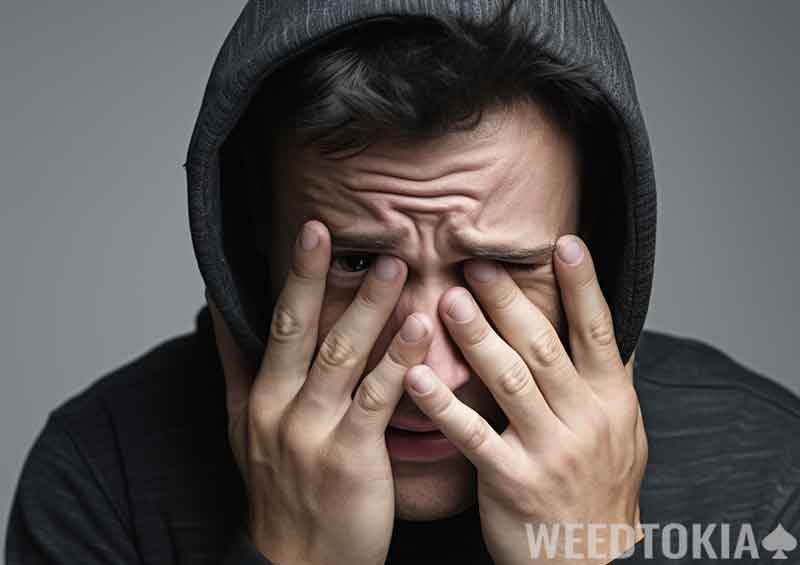
No matter which of these categories you fall into, too much cannabis can lead to severe side effects, including psychological reactions, heart complications, and cognitive impairments.
Some of the most common psychological reactions include panic, fear, and depression. On the other hand, heart-related problems that might arise with excessive cannabis use include tachycardia, or a heartbeat exceeding 100 beats per minute (60-100 is the normal resting range), and postural hypotension, meaning the blood pressure drops when you stand up from lying down.
In terms of your emotional and cognitive health, the most widespread adverse effects resulting from a cannabis overdose are depression of the respiratory and central nervous systems and impaired attention and memory.
There are numerous reasons why you might accidentally find yourself “greening out.” You may have merely eaten too many edibles in too short a period, or a drug interaction exaggerated cannabis’s effects to the point of discomfort or sickness.
TLDR: Greening Out & Avoiding It

- “Greening out” means consuming too much cannabis – or in short, you messed up.
- A person who’s greened out will experience uncomfortable symptoms (that may take a day to recover from), including panic, fear, depression, rapid heartbeat, and disorientation.
- Cannabis effects vary from person to person, and tolerance levels can change due to alcohol or factors like age and chronic diseases.
- Combing cannabis with alcohol can increase THC blood levels and intoxication.
- There are no recorded fatal overdoses from cannabis, but there are negative effects, so know your limits.
- To avoid greening out, start a low dose and take your time, avoid alcohol (or some medications), keep an icy glass of water, monitor blood sugar levels, and smoke with your buddies.
Wrap Up:
That does it for this article; let us know in the comments below if you’ve ever experienced greening out.